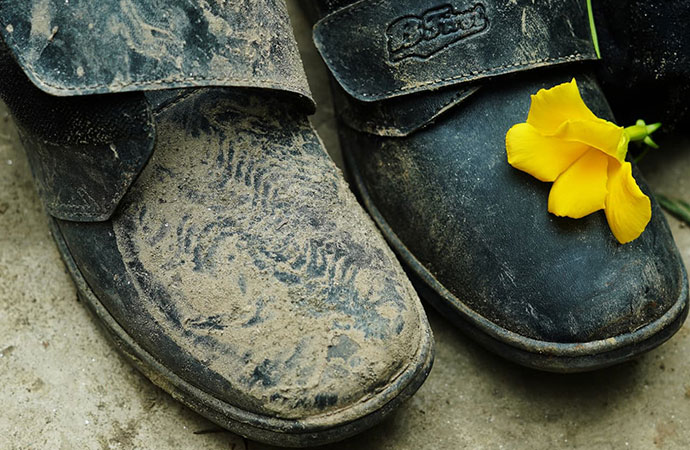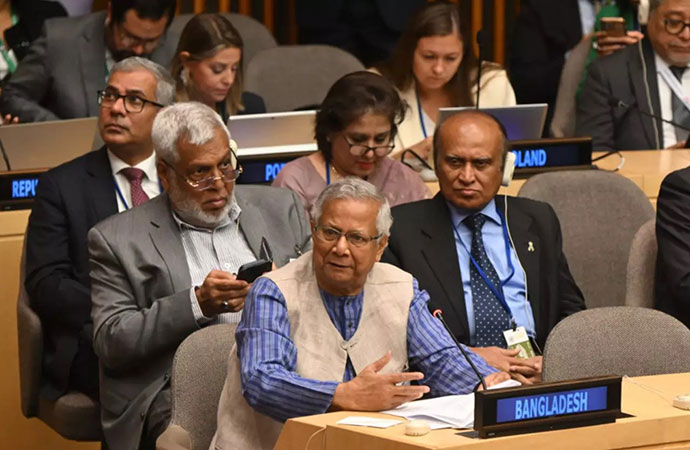Reportage

As the clock struck 1pm on Monday, July 21, Maherin Chowdhury could be seen arriving at the main gate of the Milestone School and College campus in Diyabari, right on the northern edge of Dhaka's unplanned urban sprawl. As the bell rang for the end of the school day, Maherin miss, like every other day of the week, started handing over the students rushing out of class to their guardians, her presence a source of reassurance and guidance for both students and parents alike.
Having spent 18 years at the institution and helped it grow into a formidable name in the education sector, Maherin miss was a most revered figure on campus, commanding love and respect in equal measure from all comers. She started out as a teacher, and now served as the 'Coordinator' for classes 3, 4, and 5 at Milestone's Bangla Medium section.
Her daily routine at the gate usually lasted 15-20 minutes. By then, most of the students will have left and the campus would start to clear again. On this day though, at around 1:12pm, everything would change forever. It all happened so quickly.
That is when a Chengdu FT-7BGI fighter jet operated by the Bangladesh Air Force (BAF), that had taken off just six minutes earlier from the BAF Bir Uttom A. K. Khandker Base in Kurmitola for Flight Lieutenant Towkir Islam Sagar's first solo flight, crashed into the Haider Ali Building on the Milestone School campus, entering the building on the ground floor through one side and exiting through the other.
The jet fuel caused an immediate explosion and the plane instantly took out two classrooms on the ground floor, that housed two sections of class 3 - 'Cloud' and 'Sky'. At the same time, it triggered a fire that quickly spread to adjoining classes. Even though school was out, students had been milling about the building doing various things as children do, including in the classrooms, and the lawns on both sides, or near the gate, where there were even some guardians. Everyone's world was thrown upside-down in a flash, and they probably didn't even know what had hit them.
According to multiple eyewitness accounts, Maherin miss immediately sprang into action. Instead of taking advantage of being near the gate to exit safely, Maherin ran towards the fire, not away from it. Making her way towards the building, where there was already an inferno, she would grab a child, whoever she could and from wherever she could, bring them to the gate, and go back again.
The 46-year-old English teacher went back again and again into a burning classroom to rescue her students, even as her own clothes were engulfed in flames, her brother Munaf Mojib Chowdhury told reporters. According to sources in the military, whose rescuers were some of the first to respond to the accident, Maherin must have pulled out at least 20 students with her own hands.
By the time she was done, she had suffered burns to more than 80% of her body, and although she was eventually taken to the National Burn Institute at Dhaka Medical College Hospital, she wouldn't make it through the night, leaving behind her grief-stricken husband and two teenage children.
A delegation from the Bangladesh Air Force laid a wreath of fresh flowers at the grave of Maherin, honouring her bravery and service. The solemn ceremony, held at her final resting place in Nilphamari's Jaldhaka Upazila, was attended by BAF officers who paid their respects in silence before placing the tribute.
She was one of 22 confirmed dead on the first night itself. Some 170 others were admitted in six different hospitals to receive treatment for burn injuries. Many of them were in critical condition. Over the next three days, that death toll would slowly creep up to 35 - the large majority of them being children - by the time Dhaka Courier went to press this week. Included among them was the promising young fighter pilot, Flight Lieutenant Sagar, who left behind the wife he had married just six months ago.
It gets toxic
As our editor in chief writes this week, something about the tragedy hit differently, gnawing deep at our souls. As Bangladeshis, we are mostly used to national tragedies. But something about this particular tragedy disturbed us in ways we didn't expect. Overall, rather than the strength and resolve and solidarity that we usually see coming to the fore in times of national crisis, it seemed to bring out the worst in us.
Soon after the tragedy struck, reports started appearing of rickshaw pullers in the area asking for four times the usual fare, to transport victims fighting for their lives to the nearest hospitals. CNG drivers apparently did the same, for transporting them to DMCH, on the other side of town, that houses the most advanced Burn Unit in the country. Given the size and sprawl of Dhaka, the authorities should immediately consider whether a single such facility can ever be enough really, to serve not just the entire population of Dhaka - including the outskirts, an estimated 2 crore - but also the entire nation.
Shockingly, there were also reports of vendors asking for Tk 600 for a 2 litre bottle of water. Although not unprecedented, these things are almost unheard of. And certainly doesn't jive with the stories of incredible courage and selflessness, that we witnessed during last year's July Uprising.
If one were to take a moment to survey all the different factors that came into play, we might see why the tragedy at Milestone School and College came at a particularly bad time for the nation - the wrong tragedy, in which children as young as 12 to 13 years of age were burned to their deaths, at the wrong time- with the nation still divided along the fault lines of last year's uprising. To make things worse, that raw wound was exposed again just days earlier (July 16), with the National Citizens Party's defiant rally in Gopalganj, that set off a firecracker in the hearts of the Awami League. The fallen giants' violent and utterly undemocratic reaction resulted in five people getting killed as large crowds laid siege to the NCP convoy, as they tried to leave under army protection. Eventually they had to make their exit inside the Army's APCs (armoured personnel carriers). A sight that their opponents will not let them live down.
To make things worse, the authorities responded with a crackdown under curfew in Gopalganj, that lasted till July 19. The next day, AL called a nationwide hartal in protest. Although that didn't get much of a response, it did speak to the unrest and bitterness that was tearing the nation apart, when tragedy struck, aboard Flight Lt Sagar's plane the next day.
The Blame Game
Fingers started pointing at the Air Force on two counts- flying old model aircraft that ran inherent risks, and doing so over densely populated urban centres like Dhaka.
"Please do not listen to any rumours on social media. A strong air force is essential for the sovereignty of the country. Please do not weaken this pillar of our sovereignty by spreading rumours. Like all of you, we are also heartbroken," said Air Chief Marshal Hasan Mahmood Khan, after the funeral parade of Flight Lieutenant Towkir Islam Sagar.
The chief of air staff said: "It is truly unfortunate that unrest is prevailing around the crash site. Many rumours are spreading. Do not listen to them. We are informing you of every update through ISPR, and we will continue to do so."
One of the worst rumours that started doing the rounds was of the Army, in an effort to protect their buddies in the Air Force, hiding the bodies of the dead to try and play down the scale of the tragedy. The Air Chief tried to address these vile rumours.
"You are the people of our country. An accident is an accident. We are trying to bring the situation fully under control. If unrest continues, no one else will be harmed, except for our country," he said.
Khan said he was preparing to leave the country to attend a program but returned immediately after hearing about the tragic incident.
"Plane crashes can happen. A similar tragedy recently occurred in a neighbouring country, where lives were lost. One happened here yesterday. These accidents are not frequent. But only Allah knows why such incidents take place," he said.
"However, our main task now is to recover from the damage that has been done. We have repeatedly said that we will stand by the victims. Our top priority is to ensure proper treatment for the injured. Alongside the government, the Air Force will always stand by the victims," he added.
While replying to questions from journalists, he said: "We have followed standard procedures everywhere, yet the accident happened. Even in developed countries with highly advanced fighter jets, accidents occur. Just a few days ago, even an F-37 fighter jet crashed. So, no one can guarantee that accidents will not happen. But we will certainly learn from this incident and take steps to prevent future occurrences."
He continued: "Technologically, these aircraft are now outdated. But they are not yet beyond use. We are actively working to bring in newer-generation aircraft. As you all know, we plan to procure jets with advanced technology in the future. But even those can crash; there is no guarantee they will not. That is the reality."
The air chief said that since these aircraft rely on a single engine, the air force never compromises on their maintenance. "Yes, it is old technology, but we never fly even a single extra hour beyond its permitted limit. Every necessary repair is completed thoroughly. So we have no doubt about the condition of the plane."
Body counts
The rumours around the dead bodies however, failed to died down. Stunningly, even after teachers from the school started facing the press or gave their own accounts on social media, insisting that the number of students in attendance at the time were not as high as the earlier estimates, they were dismissed and their accounts were branded 'unreliable'. Clearly, some people were hungering for something more sinister than what had actually transpired.
A volunteer, Tanim Bin Quyyum, was one of the first who managed to speak to one of the teachers at the school, to get their perspective. Tanim was able to learn that the staff were quite disturbed by the rumours floating around the school.
Some examples of these rumours were: All the students in the two sections where the plane crashed, that is, 120 people, died.
Or that all the students in the 'Sky' section died.
Or that a total of about 200 people died.
In response, the teacher, Kazi Bilkis Ara Irin, said: "The total number of students in the two sections was 35+35=70. The class ended at 1pm. Most of the children left within 10 minutes. Only those whose guardians were late, or stayed back to do extra work as they did not understand the lesson or for other reasons like that, remained. The number of such children in the two sections (combined) would be 15-20. And the plane crashed at 1:16-18pm. Most of the children left then."
She said the number of students was being wildly overestimated.
"The plane directly hit the two sections of Class Three, 'Sky' and 'Cloud'. Classes were not in session at that time. More than 35 children are not admitted to a section in grades 3-4. At the same time, some children were playing and many others from other classes were injured," she told Tanim.
"Within 10-15 minutes of the plane crash, about 100 children were taken out of the building, some of whom were injured. After first aid, many children were taken home by their parents who were slightly injured. Some were also injured who were not school-related. They were outside on the street when the plane crashed," she added.
"Two of our teachers died (this later rose to three). Everyone's full focus was on the departure of the children, rapid hospitalization, ensuring treatment, coordinating with the ministry and other departments, searching for the bodies and the injured, etc. That is why not all the children were searched immediately. Parents have been asked to contact them if their child is missing," the teacher concluded.
Her account was largely corroborated by another teacher, Purnima Das, who posted her account on social media.
"School breaks at 1pm, I entered the Sky section exactly one to two minutes before that and saw only one child standing there. No one was there, everyone had left. You don't know how during the break, the children are busy carrying their bags three or four minutes before and are ready to go home. After I left, some children entered the Sky again because their parents did not come, and another teacher of ours took them from the class and put them in another section."
Although hesitant to mention numbers, she explained which students might have still lingered in the compound at the time the plane hit:
"We lost a few (5-6 people) who entered class again. Or those who were playing in the corridor, on the swing or running around in the stairwell. Or those who happened to be there at that moment. (Their number is uncertain). Then came #cloud and there were more children there (8-10) than Sky. I think Mahreen Miss, Masuka Miss and Mahfuza Miss were trying to get the children out from there. And while trying to get them out, they themselves got burnt."
Finally, she had nothing but disdain for the rumourmongers, telling them off for their self-centred concerns and pointing out to them that no one felt more deeply for those students, than their teachers:
"And those who said about the disappearance of the body, I don't know how much trouble you have in your head. Because if we couldn't save a child, at least we would try our best to reach the body to his or her parents. You have no idea how these teachers keep the children safe all day long. When school ends, Mahreen stands in front of the gate every day and hands over the children to their guardians. As long as even one child has a guardian, she doesn't move from the gate. We are teachers, not politicians."
Thank God for them.

























Leave a Comment
Recent Posts
Religion and Politics: A Toxic ...
At Dhaka University, cafeteria workers have been told not to wear shor ...
Enayetullah Khan joins AsiaNet ...
AsiaNet’s annual board meeting and forum was held in Singapore, ...
In a New York minute
Many leaders back a UN call to address challenges to ..
Defaulted loans at Non-Bank Financial Institutions ( ..
How the late Zubeen Garg embodied cultural affinitie ..